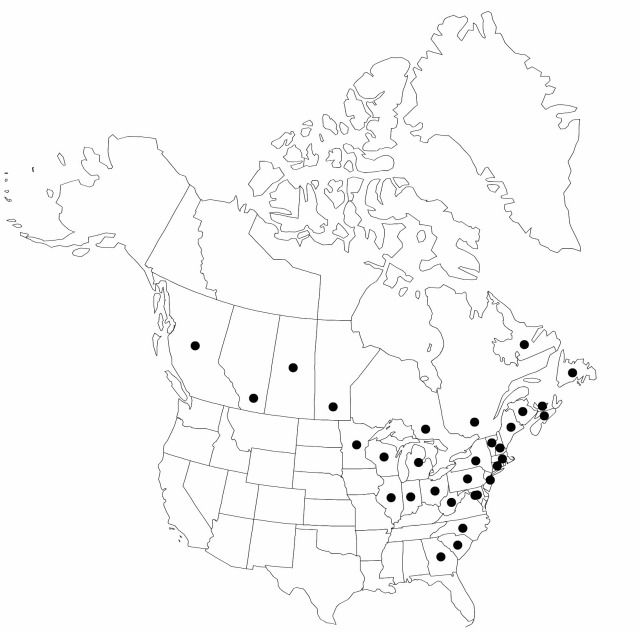Difference between revisions of "Carex tonsa"
Bull. Torrey Bot. Club 35: 492. 1908.
FNA>Volume Importer |
FNA>Volume Importer |
||
| Line 10: | Line 10: | ||
|name=Carex umbellata var. tonsa | |name=Carex umbellata var. tonsa | ||
|authority=Fernald | |authority=Fernald | ||
| + | |rank=variety | ||
|publication_title=Proc. Amer. Acad. Arts | |publication_title=Proc. Amer. Acad. Arts | ||
|publication_place=37: 507. 1902 | |publication_place=37: 507. 1902 | ||
| Line 16: | Line 17: | ||
|name=Carex rugosperma var. tonsa | |name=Carex rugosperma var. tonsa | ||
|authority=(Fernald) E. G. Voss | |authority=(Fernald) E. G. Voss | ||
| + | |rank=variety | ||
}} | }} | ||
|hierarchy=Cyperaceae;Carex;Carex sect. Acrocystis;Carex tonsa | |hierarchy=Cyperaceae;Carex;Carex sect. Acrocystis;Carex tonsa | ||
| Line 51: | Line 53: | ||
-->{{#Taxon: | -->{{#Taxon: | ||
name=Carex tonsa | name=Carex tonsa | ||
| − | |||
|authority=(Fernald) E. P. Bicknell | |authority=(Fernald) E. P. Bicknell | ||
|rank=species | |rank=species | ||
| Line 63: | Line 64: | ||
|publication year=1908 | |publication year=1908 | ||
|special status= | |special status= | ||
| − | |source xml=https://jpend@bitbucket.org/aafc-mbb/fna-data-curation.git/src/ | + | |source xml=https://jpend@bitbucket.org/aafc-mbb/fna-data-curation.git/src/f50eec43f223ca0e34566be0b046453a0960e173/coarse_grained_fna_xml/V23/V23_1011.xml |
|genus=Carex | |genus=Carex | ||
|section=Carex sect. Acrocystis | |section=Carex sect. Acrocystis | ||
Revision as of 20:04, 16 December 2019
Plants densely to loosely cespitose; rhizomes ascending to erect, brown to reddish brown, 0–10 mm, stout. Culms 4–16 cm, scabrous distally; bases (remnants of old leaves) fibrous. Leaf blades pale to bright green, equaling or exceeding stems, 0.5–4.3 mm wide, herbaceous or coriaceous, glabrous abaxially, strongly scabrous to papillose adaxially. Inflorescences with both staminate and pistillate scales; peduncles of basal pistillate spikes erect, short to elongate, stout to slender; peduncles of staminate spikes 0.8–15 mm; proximal nonbasal bracts scalelike, shorter than inflorescences. Spikes: proximal pistillate spikes 2–3 (basal spikes 1–2); cauline spikes usually overlapping with staminate spikes, with 3–10(–15) perigynia; staminate spikes 4.5–11.3 × 1.1–3 mm. Scales: pistillate scales pale brown to reddish brown, with narrow white margins, ovate, 2.9–4.1 × 1.5–1.9 mm, equaling or exceeding perigynia, apex acute to long-acuminate; staminate scales ovate, 4.2–5.4 × 1.2–2.1 mm, apex obtuse or acute to acuminate. Anthers 1.6–2.9 mm. Perigynia green to pale brown, veinless, ellipsoid, obtusely trigonous in cross section, 3.1–4.7 × 1.1–1.6 mm; beak straight, pale green, occasionally with reddish brown tinge near apex, strongly 2-edged, 0.9–2 mm, smooth or ciliate-serrulate, apical teeth 0.2–0.5 mm. Stigmas 3. Achenes brown, ellipsoid to obovoid, obtusely trigonous in cross section, 1.6–2 × 1.2–1.6 mm.
Distribution

North America.
Discussion
Varieties 2 (2 in the flora).
Selected References
None.
Lower Taxa
Key
| 1 | Perigynia with few hairs near base of beak, otherwise glabrous; leaves pale green, often relatively short, coriaceous, usually smooth adaxially. | Carex tonsa var. tonsa |
| 1 | Perigynia pubescent on beak and body; leaves bright green, much longer than culms, herbaceous, scabrous to papillose adaxially. | Carex tonsa var. rugosperma |